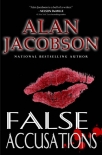False Accusations Jacobson, Alan (books successful people read .TXT) 📖

Book online «False Accusations Jacobson, Alan (books successful people read .TXT) 📖». Author Jacobson, Alan
Warwick looked perturbed for a moment. He had committed the cardinal sin in cross-examination: he had asked a question without making sure he knew the answer that was coming. But in fact, there was no way that Warwick could have known that Ross was going to cite cutting-edge research and methodology.
“How big a sample of DNA are we talking about in this particular case against my client?”
“The DNA was obtained from saliva residues on a beer can, so there was more than enough to get an accurate result.”
Denton knew that Warwick was well aware of that very unfortunate fact.
The public defender cocked his head. “How big is a molecule of DNA?”
“It’s microscopic.”
“So it’s nothing we can really see with the naked eye. It’s nothing that I or any of the jurors could look at and see for ourselves.”
“No. But I assure you it exists and is quite real.”
“Uh-huh,” Warwick said, as if to mock Ross’s last comment. “You said earlier while being questioned by Mr. Denton that DNA can become contaminated?”
“Yes.”
“What are some of the ways in which this can occur?”
“A number of factors or situations.”
“Can you name some?”
“Improper handling of the evidence, improper storage conditions, high humidity, excessive dirt, dust, things of that nature.”
“What about sneezing? Could that spoil a sample?”
“Yes.”
“Coughing?”
“Yes.”
“Hmm,” Warwick said, pacing away from the witness.
The jurors’ eyes followed him. “Something as benign as a sneeze could contaminate the sample.”
“Yes, but—”
“And how much time elapsed between the time that the evidence was gathered and the actual lifting of the saliva from the cans?”
“As I said earlier, I believe six weeks.”
Denton felt pimples of sweat forming on his forehead.
“Six weeks,” Warwick said. “And you said dust or even dirt could contaminate the sample?”
“Again, as I said a moment ago, yes. But it would have to be—”
“And when a DNA sample is contaminated, the results that it yields are then no longer considered accurate.”
“I suppose you could say that.”
Warwick had stopped and leaned back against the defense table, arms folded across his chest. He looked hard and long at Ross, as if he were pondering what he had just answered. It was no doubt intended as an exclamation point for the jury. “Yes, I suppose I could. Thank you, Dr. Ross. I have nothing further.”
“Redirect, Mr. Denton?” Calvino asked.
“Yes, Your Honor.” He stood rapidly and walked to the spot in front of the witness stand, facing Ross. “Doctor, was the sample in question contaminated?”
“No. Not to my knowledge.”
“Was the evidence properly stored, in a facility where there were no unusual amounts of humidity, direct sunlight, dust, or dirt?”
“From what I’ve read in the report, standard protocol was followed, and the evidence was properly marked, stored, and handled.”
“How does sneezing or coughing contaminate a sample?”
“Contamination occurs because you have someone else’s DNA intermixing with the sample DNA. It’s only a concern when you’re dealing with a very small sample, which, as I said, is not the case here. However, even if it were, we would be able to separate out the DNA from the person who sneezed or coughed from the DNA of the suspect.”
“It sounds very sophisticated.”
“It is,” Ross said. “Very sophisticated.”
“And accurate?”
“Extremely accurate.”
“If a DNA sample were contaminated or degraded by dirt or dust, or any such substance, would the tainted analysis come back with results implicating Brittany Harding?”
“No, the results would either be incomplete or unmatchable.”
“And that was not the case here?”
“No.”
“They clearly matched Brittany Harding’s DNA?”
“Yes, they did.”
“Is there any reason to believe that the results produced by the DNA analysis in this case were tainted, degraded, contaminated, or otherwise rendered inaccurate?”
“Absolutely none whatsoever.”
“Thank you, Dr. Ross.”
Denton walked back to the prosecutor’s table, threw a look of triumph at Warwick, and sat down. Warwick’s strategy of attempting to place doubt in the minds of the jurors was neutralized by Denton’s pointedly successful redirect; he was gathering momentum, which was exactly what he wanted as he led into his next witness, Mark Stanton.
Stanton, impeccably dressed and imposing by way of his wholesome good looks and articulate manner, seduced the jury as he told of Harding’s false claims of sexual harassment. As he spoke, Harding seated at the defense table, rolled her eyes and shook her head.
The jury listened intently as Stanton described his conversation with Movis Ehrhardt. Denton inquired about the video they were about to play. Stanton explained why it was made, who made it, the date it was filmed, and the manner in which the filming was accomplished.
Warwick objected again to the showing of the video for the record, citing its lack of foundation and relevance, and its highly prejudicial nature. Calvino overruled the objection, and the bailiff was instructed to initiate playback.
As expected, it had the same effect on the jury as it had had on everyone else who had viewed it—some of the jurors looked at Harding afterward, their faces betraying their thoughts: how could someone be so cold and calculating? She turned away to avoid their gazes, as clear an admission of guilt as there was without overtly entering a guilty plea.
Denton extracted from Stanton the reasons for his reluctance to testify, and by the time he finished, he had all the jurors’ sympathies...while Harding had all their wrath.
To cap off the day, Denton finished with a mere formality: the private investigator who filmed the video—verifying the date and time when it was created, and what he observed. He flawlessly reiterated Stanton’s story.
Warwick had no questions for either of them; the damage had been done, and belaboring the subject would only drive home the image of Harding’s admission of extortion.
Although Warwick undoubtedly wanted to ignore the repulsive content of the tape and move on, Denton was hoping





Comments (0)